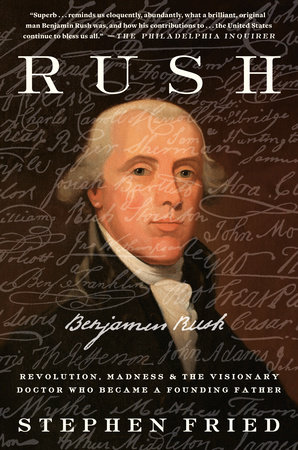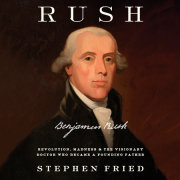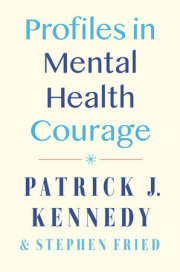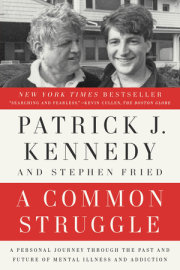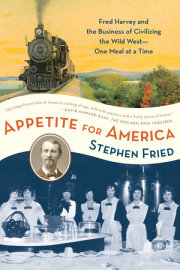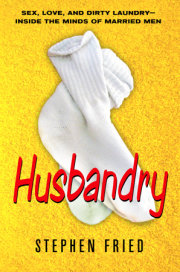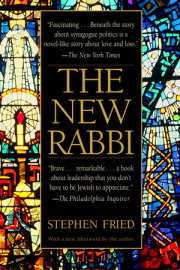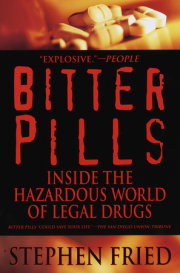1
Benjamin Rush’s “first unwelcome noise in the world” rang out from a second-floor bedroom of the stone farmhouse in Byberry, northeast of Philadelphia, on Christmas Eve, 1745.
His cries were heard downstairs in the first-floor common room, where the Rush family had been gathering at the hearth for three generations. The room had gone from a place for “conversations about wolves and bears and snakes in the first settlement of the farm” to a place for discussions “about cows, and calves and colts and lambs, and the comparative exploits of reapers and mowers and threshers,” as Rush’s grandfather had shifted from simple farming to metalwork, and Rush’s father, John, developed as a talented blacksmith and gunsmith.
The news of Benjamin’s birth was greeted with thanks to God. The Rush family were “pious people,” their conversations infused “at all times with prayers and praises, and chapters read audibly from the Bible.”
The Rushes were also quietly defiant people. An old sword hung in the farmhouse—and in every subsequent place Benjamin Rush lived—that had been carried into battle by his great-grandfather, John, a horse trooper in Oliver Cromwell’s army during its fight against the Crown in the English Civil War. The family had left the Church of England to become Quakers, then fled England for America with William Penn in 1683. There they split off from their original Quaker group of Byberry Friends in 1691, before departing Quakerism altogether to become Baptists, and eventually circling back around to the Church of England.
Benjamin Rush was the fourth of seven children and the second-eldest son. His father, John, was quiet and stolid, and what he lacked in formal education he made up for with hard work and “a talent for observation and combination”—an ability to understand people and connect dots that others didn’t even see. While he didn’t talk a lot, what he said was often notable; Rush’s mother remembered that when their children began to speak, her husband said, “The first words of a child, and the last words of a saint, are the sweetest music in the world.” Rush’s mother, Susanna Hall Rush, was five years older than John and came from a more affluent family in nearby Tacony. She had attended boarding school in Philadelphia and was considered “a woman of a very extraordinary mind,” full of energy and insight. She had been married once before, a pairing recalled as “unfortunate” and “full of misery,” ending with her husband dying young of “extravagance and intemperance.”
Rush spent the first several years of his life on the family farm, with his older brother James, his sisters Rachel and Rebecca, and a younger brother, Jacob: five children born over seven years. Susanna raised them with help from her daughter from her previous marriage, a cook, and several farmhands. Rush’s strongest memories of the farm were of the apple orchard his father cultivated, and a “small but deep creek abounding with pan fish.” The boys fished, shot and hunted, learning respect for the guns their father made and repaired—flintlock pistols, muskets, and the new American long rifle.
Rush was a thin, sturdy boy, with light-colored hair, expressive blue-gray eyes, a long nose, and a thin-lipped mouth that he almost never shut. He was aggressively curious about facts, opinions, Scripture, and people, to the point of seeming intellectually and personally nosy. He was clearly precocious but was not as serious-minded as his parents would have liked. “Those who knew me at that time,” he recalled, “would remember me only as an idle, playful, and I am sorry to add, sometimes a mischievous boy.”
Besides the farm in Byberry, John Rush’s family owned property in Philadelphia, thirteen miles southwest down the Delaware River. There was more demand there for his talents, so he began working in the city, setting up shop in a building his mother’s family owned. Eventually he decided to leave the farm and move his family from the serene countryside into what was becoming the largest city in the American colonies—where life was percolating, screeching, and reeking of whichever way the wind was blowing.
Philadelphia had just overtaken Boston as the most populated city in America, with over fifteen thousand of its 1.2 million inhabitants, and Pennsylvania was becoming the most powerful American colony. The city was in the midst of an American-style Enlightenment, much of it instigated, or at least personified, by the celebrated Benjamin Franklin. Tall and solidly built, with long, light brown hair and a wide, easy smile, Franklin was now in his early forties. As a teenager, he had moved to Philadelphia from Boston, gotten involved in the printing business, and founded the famed Junto, a combination salon and debating society that became a cornerstone of free thinking and the propagation of what he called “useful knowledge.” He then helped create a successful newspaper, the Pennsylvania Gazette, wrote and published the contagiously quotable Poor Richard’s Almanac, and began using his powers of civic persuasion to convince fellow citizens to help him build new institutions, including the first volunteer fire company, the first fire insurance company, and the first public library. In 1748, with change still coming too slowly for him, he retired from his printing business to dedicate his life to scientific study, politics, and civic entrepreneurship.
The Rush family arrived in town in the late 1740s, just as some of Franklin’s most ambitious and transformative projects were coming to fruition. Thanks to his efforts herding rich and smart people, Philadelphia suddenly had the nation’s first secular college and its first public hospital; in his spare time, Franklin had just published a paper proposing to prove lightning was electricity by experimenting with a kite in a storm.
John Rush settled his family in a house at number 82 N. Front Street, just a block north of the city’s main commercial thoroughfare, its spinal cord. The wide avenue had originally been named High Street, like the main street in most English cities. But because William Penn had designed a large outdoor market to run up its center, with stalls that were busy year round, everyone referred to the street as “Market.” (The produce sellers were often called the “Jersey Market,” because so many of them brought produce and animals across from New Jersey on barges.) On either side of Market Street were many of the city’s main stores and business offices, including, on the 300 block, Franklin’s print shop and home.
Just north of Market on Second Street was Christ Church—the city’s largest and most prestigious, at that time affiliated with the Church of England. Franklin worshipped there on Sundays in his family’s reserved pew. While Rush’s mother was Presbyterian, and had been raising the children in her faith on the farm, when they moved into town John had the family join Christ Church in part because it was the right thing to do for business; Benjamin Rush was baptized there and it was the first place he ever “heard divine worship.”
Just south of Market on Chestnut at Fifth was the Pennsylvania State House, the seat of government for the commonwealth. Because political business was booming, too, the colonial assembly had decided to expand the building, with an addition topped off by the city’s tallest structure: its first major clock tower with a new bell, the largest in the colonies, which would be used to mark time, sound for official meetings, and ring out for fires and other emergencies.
Just across the way from the Rush’s front door was the vast port of Philadelphia itself, the most active and profitable in America. It was crowded with boats from around the colonies and the world, which arrived there by sailing south, below the southern tip of New Jersey, and then up through Delaware Bay to the river. Philadelphia was bounded by another, smaller river to the West, the Schuylkill—but that was thirty blocks from the Delaware, almost in the countryside, and therefore much less of a thoroughfare. A tributary of the Delaware, the Dock Creek, flowed into the city around Spruce Street and served mostly as an open sewer and a place for local tanneries and other businesses to dump their waste.
John Rush’s blacksmith shop was on the first floor of a three-story redbrick building, and the family lived upstairs. Benjamin enjoyed the sounds and tactile pleasures of his father’s heavy iron tools and the flintlock rifles and pistols he built and repaired. It didn’t take John long to build up his business; more and more men were carrying guns instead of swords, so demand was good, and he developed a dependable reputation. As a child, Benjamin Rush often heard that one of the highest compliments you could receive in the neighborhood was to be told you were “as honest as John Rush.”
John and Susanna Rush had two more children in Philadelphia: a daughter, Stephenson, who died within a year, followed by a son, whom they named John. But not long after the birth of his namesake, in the summer of 1751, John Rush unexpectedly died. He was only thirty-nine years old, and his mischievous son Ben (as he was called then) was only five and a half. Almost nothing is known about John Rush’s death, and his son never speculated on what illness took him. He only related that “his death was peaceful and happy” and “the last words he uttered were ‘Lord! Lord! Lord! Lord!’ ”
Weeks after her husband’s death, Susanna Rush also lost her new baby. Father and son were buried together, on August 19, 1751, in one grave at the Christ Church burial ground. And Susanna Rush, then forty-four, was left to raise three boys and two girls ranging in age from four to twelve. Her situation became more grim when it became clear her husband had not left her enough money to support the family and school the children.
That fall, while settling his estate, she was forced to rent out his shop space and sell off his blacksmithing tools. She also offered for sale several people she could no longer afford, beginning with a “likely negroe woman [who] has had the small-pox and measles,” as she advertised in the Pennsylvania Gazette. In an expanded version of the advertisement, two months later, she offered “to be sold two Negro women, one of which has two children, can do all manner of house-work and is fit for both town or country business.”
These ads suggest that, at some point, either Susanna or her husband had inherited or bought slaves, at least one of whom might have been with them back on the farm. An ad several years later (when Rush was nine) shows her selling two more servants. One of them is described as “a white lad” who “has upwards of three years to serve”—which means he was probably an “indentured” servant, his exclusive employment paid and contracted for over a set period of time. The other, a twenty-seven-year-old “Negroe woman . . . an excellent cook, understands a dairy very well, and is fit for a gentleman’s country house,” was likely a slave.
Benjamin Rush never mentioned that his family owned slaves when he later started writing passionately against the practice. But these women were likely the first slaves he knew as a child, and they helped raise him. They certainly informed his earliest ideas about slavery and race—as did living a block and a half from the main slave auction stand for Philadelphia’s port, located in front of the Indian King Tavern, on Market just past Second. It wasn’t far from Rush’s house, and he may very well have been able to hear the auctions from his bedroom window.
With the proceeds from the estate sale, Susanna Rush opened a store around the corner on the south side of Market Street, four doors below Second. Her shop didn’t have a name, just a sign painted with what appeared to be a comet, so its location was “at the Sign of the Blazing Star.” (Numbered addresses were uncommon; most stores oriented themselves by proximity to landmarks and street corners.) The store at the Blazing Star sold food and liquors, both wholesale and retail, and became fairly successful.
Susanna quit Christ Church and began worshipping instead at the Presbyterian meeting house two blocks away on Fourth Street. It was led by forty-nine-year-old Rev. Gilbert Tennent, a rousing Irish-born evangelical orator who, like his father before him, was considered part of the spiritual “Great Awakening” in the colonies. Besides her preference for Tennent’s fiery sermons, the switch probably had something to do with the fact that her younger sister, Sarah Hall, had married a close friend of Tennent’s, the Rev. Samuel Finley. After a period on the pulpit, Reverend Finley had left to start a boarding school in Maryland, the West Nottingham Academy, which was a favorite of well-to-do Philadelphia families.
Tennent seemed like a good father figure and role model for her boys. And Reverend Finley’s boarding school, if she could save up the money to pay for it, would offer them a chance for a prestigious religious and secular education, under the watchful eye of family.
This was especially important for Benjamin, who even at age six was demonstrating what some called a “genius for learning.” He had an astonishing memory—not only amazing recall but an ability to make subtle connections that was even more pronounced than his father’s. Susanna felt certain that Benjamin would benefit from boarding school, imagining that he might be inspired to join the clergy himself someday and spread the gospel. She expected her youngest son, Jacob, to go to boarding school as well. However, she apparently did not have similar optimism for her eldest son, James. Six years older than Benjamin, he was, Rush recalled, “a young man of promising character” who was “much afflicted with a nervous disease” after his father’s death; his physicians “advised a sea-life,” so he left home as a teen to work on ships.
Susanna Rush worked hard to keep her household going and scrape together the money to send Benjamin and Jacob to school, building up her business and eventually buying another building on the other side of Market Street to open a china shop. She raised her family without a husband for nearly four years—along with a cook and a servant and her daughter from a previous marriage. And she prospered, as one of colonial Philadelphia’s few female entrepreneurs.
She was not, however, as fortunate in love as in business. In 1755 she married a local distiller, Richard Morris, who Rush recalled as “rough, unkind and often abusive” to her. Luckily, by the time the new husband arrived—or perhaps because of his arrival—Benjamin and Jacob were away at school.
The West Nottingham Academy was sixty miles from Philadelphia, near where the Susquehanna River crosses from Pennsylvania into Maryland—a bucolic setting far from city life. The school building was a simple log structure, near the large stone mansion house where the headmaster, Finley, lived with his wife, Rush’s Aunt Sarah, and their children. Over the next five years Benjamin and Jacob lived in the mansion as well, along with all the other boys studying at the academy. Between family, students, and employees, there were generally about thirty people on the West Nottingham grounds, all committed to the moral education of young men.
Copyright © 2018 by Stephen Fried. All rights reserved. No part of this excerpt may be reproduced or reprinted without permission in writing from the publisher.

